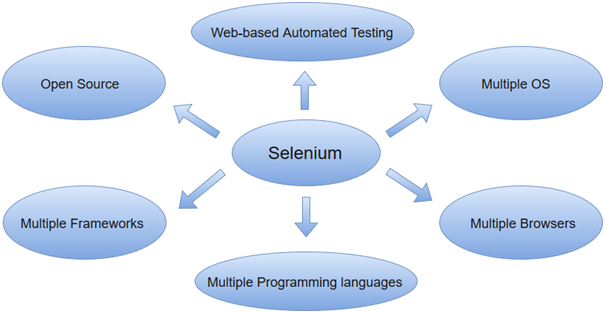Selenium Tutorial
Selenium IDE
Selenium WebDriver
selenium Misc
Selenium Python
Selenium C#
Selenium Maven
Selenium Interview Questions
Selenium Tutorial
Selenium Tutorial

Selenium tutorial provides basic and advanced concepts of Selenium. Our Selenium tutorial is designed for beginners and professionals.
Selenium is one of the most widely used open source Web UI (User Interface) automation testing suite.
Our Selenium tutorial includes all topics of Selenium such as Features, Selenium vs QTP, Selenium Tool Suits, Selenium IDE, Selenium IDE Locating Strategies, Selenium WebDriver, WebDriver Features, WebDriver vs RC, WebDriver Installation, etc.
What is Selenium
Selenium is one of the most widely used open source Web UI (User Interface) automation testing suite.It was originally developed by Jason Huggins in 2004 as an internal tool at Thought Works. Selenium supports automation across different browsers, platforms and programming languages
Selenium can be easily deployed on platforms such as Windows, Linux, Solaris and Macintosh. Moreover, it supports OS (Operating System) for mobile applications like iOS, windows mobile and android.
Selenium supports a variety of programming languages through the use of drivers specific to each language.Languages supported by Selenium include C#, Java, Perl, PHP, Python and Ruby.Currently, Selenium Web driver is most popular with Java and C#. Selenium test scripts can be coded in any of the supported programming languages and can be run directly in most modern web browsers. Browsers supported by Selenium include Internet Explorer, Mozilla Firefox, Google Chrome and Safari.

Selenium can be used to automate functional tests and can be integrated with automation test tools such as Maven, Jenkins, & Docker to achieve continuous testing. It can also be integrated with tools such as TestNG, & JUnit for managing test cases and generating reports.
Selenium Index
Selenium
- Selenium Tutorial
- Selenium Basic Terminology
- Selenium Features
- Selenium Limitations
- Selenium vs QTP
- Selenium Tool Suite
Selenium IDE
- Selenium IDE
- IDE-Installation
- IDE-Features
- IDE-First Test Case
- IDE-Login Test
- IDE-Commands
- IDE-Creating Test Cases Manually
- IDE- Locating Strategies
- IDE- Locating by Identifier
- IDE- Locating by ID Element
- IDE- Locating by Name
- IDE- Locating by XPath
- IDE- Locating by CSS
- Locating by ID
- Locating by Class
- Locating by Attribute
- Locating by ID/Class & Attribute
- Locating by Sub-string
- Locating by inner text
- IDE- Locating by DOM
Selenium WebDriver Tutorial
- Selenium WebDriver
- WebDriver-Architecture
- WebDriver-Features
- WebDriver Vs RC
- WebDriver-Installation
- First Test Case
- WebDriver Commands
- Running Test on Chrome
- Running Test on Firefox
- Running Test on IE
- Running Test on Safari
- Locating Strategies
- Locating Strategies By ID
- Locating Strategies By Name
- Locating Strategies By Class Name
- Locating Strategies By Tag Name
- Locating Strategies By Link Text
- Locating Strategies By Partial Link Text
- Locating Strategies By CSS
- Tag and ID
- Tag and Class
- Tag and Attribute
- Tag, Class and Attribute
- Sub-String Matches
- Locating Strategies By XPath
- Using Single Slash
- Using Double Slash
- Using Single Attribute
- Using Multiple Attribute
- Using AND
- Using OR
- Using contains()
- Using starts_with()
- Using text()
- Using last()
- Handling Drop-Downs
- WebDriver-Drag and Drop
- WebDriver-Handling Alerts
- Scrolling a Web Page
- WebDriver - Browser Commands
- WebDriver - Navigation Commands
- WebDriver - WebElement Commands
- Handling Radio Buttons
- Handling Checkbox
- Selenium Assertions
- Selenium Grid
Selenium Python Tutorial
- Selenium Python
Selenium C# Tutorial
- Selenium C#
TestNG with Selenium
- TestNG Tutorial
- TestNG Introduction
- TestNG Installation
- Features of TestNG
- Running Test Cases
- TestNG XML File
- Exclude/Include Test Cases
- Running Test Cases with Regex
- TestNG Groups
- TestNG Annotations
- 1) @BeforeSuite
- 2) @AfterSuite
- 3) @BeforeTest
- 4) @AfterTest
- 5) @BeforeClass
- 6) @AfterClass
- 7) @BeforeMethod
- 8) @AfterMethod
- 9) @BeforeGroups
- 10) @AfterGroups
- Annotation Attributes
- TestNG Parameters
Prerequisites
Before learning the concepts of Selenium, you should have a basic understanding of java or any other object-oriented programming language.
Languages supported by Selenium include C#, Java, Perl, PHP, Python and Ruby.Currently, Selenium Webdriver is most popular with Java and C#. So, if you know any of the languages then it won't be tough to understand the concepts of Selenium. In addition, you should have prior knowledge of software testing techniques like automation testing, functional testing, etc.
Audience
Our Selenium Tutorial is designed for all beginners and advanced-level Selenium users.


